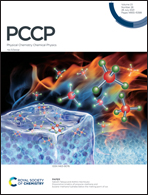Core–shell PdAu nanocluster catalysts to suppress sulfur poisoning†
Abstract
Reducing sulfur poisoning is significant for maintaining the catalytic efficiency and durability of heterogeneous catalysts. We screened PdAu nanoclusters with specific Pd : Au ratios based on Monte Carlo simulations and then carried out density functional calculations to reveal how to reduce sulfur poisoning via alloying. Among various nanoclusters, the core–shell structure Pd13Au42 (Pd@Au) exhibits a low adsorption energy of SO2 (−0.67 eV), comparable with O2 (−0.45 eV) and lower than CO (−1.25 eV), thus avoiding sulfur poisoning during the CO catalytic oxidation. Fundamentally, the weak adsorption of SO2 originates from the negative d-band center of the shell and delocalized charge distribution near the Fermi level, due to the appropriate charge transfer from the core to shell. Core–shell nanoclusters with a different core (Ni, Cu, Ag, Pt) and a Pd@Au slab model were further constructed to validate and extend the results. These findings provide insights into designing core–shell catalysts to suppress sulfur poisoning while optimizing catalytic behaviors.



 Please wait while we load your content...
Please wait while we load your content...